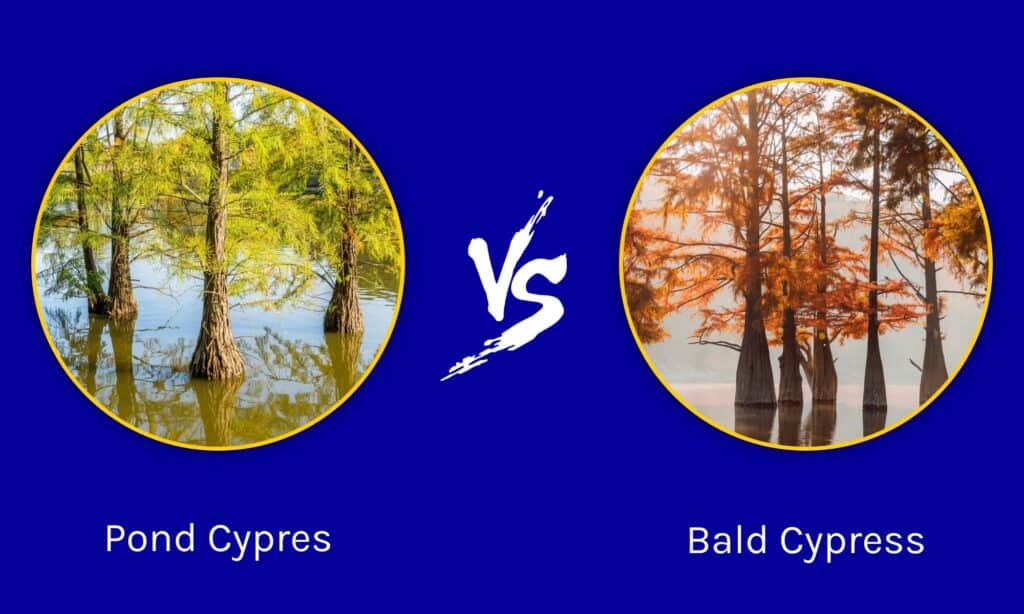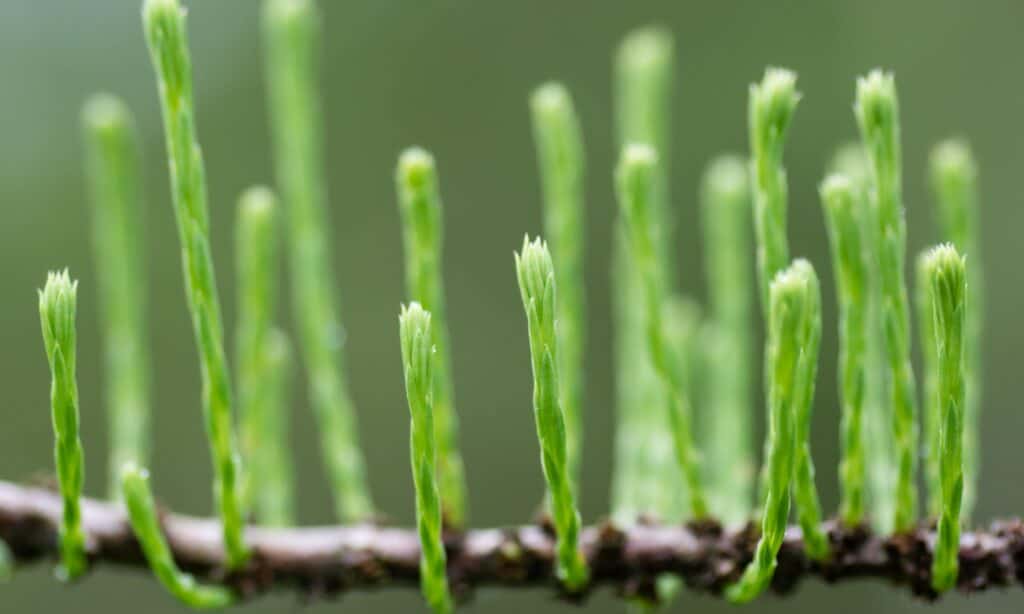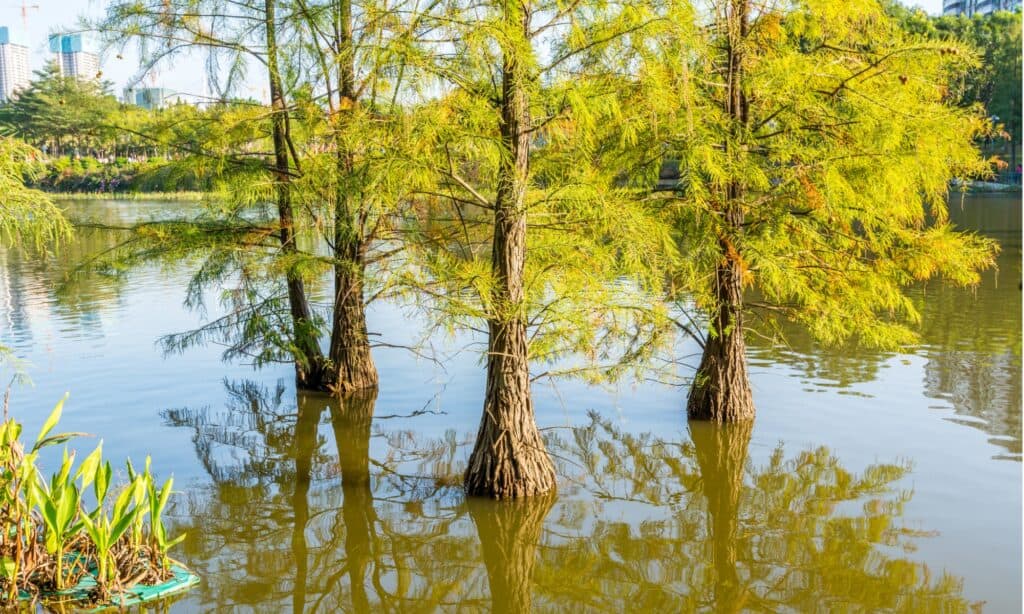Whether you are interested in planting one or simply enjoy learning about trees, there are a number of differences between a pond cypress vs bald cypress. But what might some of these differences be, and how can you learn how to tell a bald cypress tree apart from a pond cypress tree?
In this article, we will compare and contrast everything you need to know about both the bald cypress and the pond cypress so that you can tell them apart. We will address their physical descriptions as well as their preferred growing locations. That way, you can learn which tree works best for you and your location in case you want a cypress in your own backyard! Let’s get started.
Comparing Pond Cypress vs Bald Cypress

| Pond Cypress | Bald Cypress | |
|---|---|---|
| Classification | Taxodium ascendens | Taxodium distichum |
| Description | Reaches 45-60 feet tall on average. Short leaves or needles that grow erect along the branch rather than spreading. Bark is a pale gray and the trunk spreads out along the bottom, otherwise maintaining a very narrow profile. | Reaches 30-125 feet tall on average. Unique root and trunk systems allow this tree to grow in swamps or along riverbanks. Needles are lacy and long, turning colors before falling each winter. Bark is gray-brown in color. |
| Uses | Great for solidifying watery shores, or ideally planted in extremely narrow locations | The heartwood of this particular tree resists many forms of decay, making it ideal for construction work |
| Hardiness Zones and Care | 5-10; prefers moist soil and partial shade, though some sunlight is necessary | 4-10; enjoys moist but well-drained soil, though adapts well to sandy or drier soil. Prefers full sun over shady conditions |
| Special Features | Often grown near still-moving waters and lives for thousands of years! | Called “bald” because it sheds its needles in the fall! |
Key Differences Between Pond Cypress vs Bald Cypress

The needles on the pond cypress grow upward, while the needles on the bald cypress spread out.
©iStock.com/corridor91
There are a number of key differences between pond cypress trees and bald cypress trees. While some people claim that pond cypresses are just a bald cypress variety, these two trees have distinct species classifications. In addition, the bald cypress grows larger than the average pond cypress. Finally, the needles on the pond cypress grow differently from the needles on the bald cypress.
Let’s take a look at these differences in more detail now.
Pond Cypress vs Bald Cypress: Classification
While there has been a long-standing debate regarding whether or not these two trees are different species, pond cypresses and bald cypresses have different classifications. For example, the pond cypress is classified as Taxodium ascendens, while the bald cypress is classified as Taxodium distichum. This makes them closely related, but different species.
Pond Cypress vs Bald Cypress: Description

These trees have different needles from one another, with the pond cypress having shorter leaves overall compared to the bald cypress.
©iStock.com/Ian_Redding
It can be incredibly difficult to tell the difference between a pond cypress and a bald cypress at first glance. Both of these trees grow in an extremely unique way, with bowed out bottoms toward the end of their trunks, in order to grow in watery environments. However, there are some differences between these two trees.
For example, the bald cypress grows much taller than the average pond cypress, and grows wider as well. The bark of the pond cypress is more gray than the bark of the bald cypress. These trees also have different needles from one another, with the pond cypress having shorter leaves overall compared to the bald cypress. In addition, the needles on the pond cypress grow upward, while the needles on the bald cypress spread out.
Pond Cypress vs Bald Cypress: Uses

The bald cypress grows much taller than the average pond cypress, and grows wider as well.
©iStock.com/Nuture
Both the pond cypress and the bald cypress have similar uses, given their relation to one another. Cypress wood is ideal for multiple construction applications, and the heartwood of the bald cypress is resistant to a number of diseases and decay. It is likely the same could be said for the pond cypress, but it is used less than the bald cypress for construction work, likely due to its smaller size.
Both of these trees are ideal for growing along rivers and in swamps, though the pond cypress is perfect for narrow locations compared to the wider bald cypress. You can even grow both of these trees in a more traditional setting, away from water, but they both enjoy being in close proximity to rivers or swamps.
Pond Cypress vs Bald Cypress: Hardiness Zones and Care
The care for both of these trees is strikingly similar to one another, though there are a few key differences. For example, the bald cypress grows best in hardiness zones 4 through 10, while the pond cypress grows in hardiness zones 5 through 10. In addition, the bald cypress prefers direct sunlight for most of the day, while the pond cypress prefers partial shade. Both of these trees need plenty of water in order to survive, though bald cypresses tend to need less care than pond cypresses.
Pond Cypress vs Bald Cypress: Special Features

The bald cypress grows best in hardiness zones 4 through 10, while the pond cypress grows in hardiness zones 5 through 10.
©iStock.com/ZZ3701
While both of these trees are extremely special in the way that they grow and adapt to water, there are some additional things to note about them. For example, the bald cypress is known as the bald cypress because it sheds its needles every year rather than maintaining them. In addition, the pond cypress is known as the pond cypress because it greatly enjoys growing near still-moving water.
There is one special feature that both of these trees share with one another: they are both extremely long-lived. These trees are capable of living thousands upon thousands of years, with some estimates reaching as high as three thousand years or more. These are great trees to plant, especially when you consider just how long they’ll be around for!
The photo featured at the top of this post is © iStock.com/Nuture
Thank you for reading! Have some feedback for us? Contact the AZ Animals editorial team.






